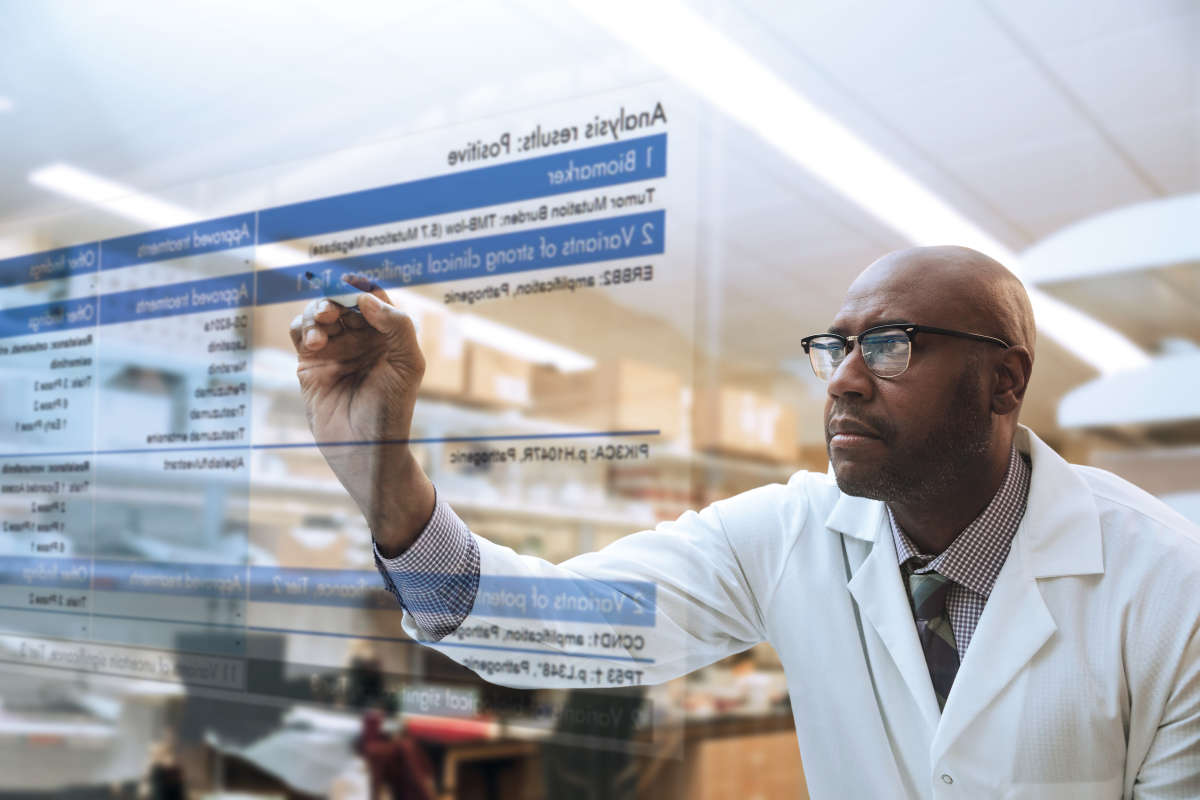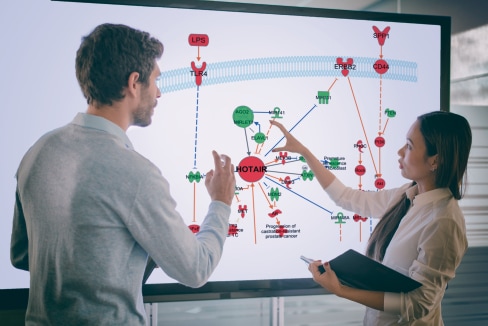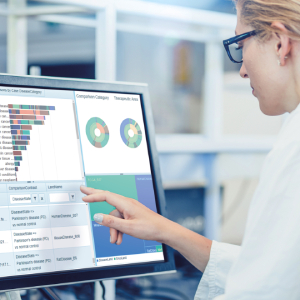














As treatments are increasingly tailored to an individual for greater efficacy, understanding the immune repertoire becomes more critical. B-cell receptor (BCR) reconstruction plays a crucial role in understanding the immune system’s response to various stimuli. Our immune system produces B cells, which carry unique receptors on their surfaces. These receptors act like keys, explicitly recognizing and binding to foreign invaders like viruses or bacteria. By reconstructing BCRs from single-cell RNA-seq (scRNA-seq) data, we can gain valuable information on the diversity and specificity of the immune response at the single-cell level.
Have you ever had to put a jigsaw puzzle together? That’s what happens when BCRs are reconstructed from scRNA-seq data. Choosing the right tool to assemble your numerous small pieces of data then becomes vital for achieving accurate results. But with so many software options out there, which one takes the crown?
A recent publication (1) compared the performance of several popular tools for BCR reconstruction with scRNA-seq data, namely:
Abdul R. Estalefi and Mathias Østergaard Mikkelsen, students of the Department of Biological and Chemical Engineering at Aarhus University, replicated the study and added QIAGEN CLC Genomics Workbench v.23.0.5 (CLC) to the mix, equipped with the Biomedical Genomics Analysis plugin. Specifically, the Immune Repertoire Analysis tool of CLC was used, which was developed for bulk RNA-seq data. Each single cell was treated as a separate sample. See the complete workflow.
The following dataset types were analyzed:
Real data: Datasets with BCR sequences from actual immune cells (plasmablasts) obtained from earlier studies
Simulated data: Datasets mimicking real-world scenarios with mutations in the BCR genes (heavy and light chains).

The results, detailed here, show that:
When working on BCR reconstruction (or NGS data in general), you want a tool with everything you might need. CLC offers a comprehensive toolset for immune repertoire analysis of single-cell data, among other applications.
You also need a software package that is easy to set up, does not require coding and works across various hardware. There would be no need to invest in new hardware and spend weeks or months learning a programming language. This makes it easier to get started and enables you to generate insights from your data right away. Remember – the right tools can take your research to the next level.
Learn more or request a trial of CLC Genomics Workbench, your all-in-one toolkit.
References:
Author acknowledgments: We thank Dr. Tommaso Andreani, Senior Principal Data Scientist at Sanofi, for continuous support and encouragement during this study.

Figure 1. CLC workflow used for dataset analysis.
The samples were handled in parallel using the Iterate element, and the results were aggregated for all samples using the Collect and Distribute elements. FASTQs pre-processed with the Trim Reads tool were used as workflow inputs. The per-sample part of the workflow consisted of three steps: (1) de-novo assembly, (2) consensus sequence extraction and (3) Immune Repertoire Analysis. IMGT Human BCR segments were used as reference segments. Compare Immune Repertoires produced the final output containing the clonotypes across all samples, which were exported to .csv to compare with the truth and compute the scores. A MacBook® Pro 2021 with an M1 Pro processor and 32 GB RAM was used to run the workflow.

Figure 2. Heat map showing each method's individual and average scores (y-axis) for the four datasets (x-axis). Leiden, Canzar and Upadhyay used plasmablast SMART-seq datasets with Sanger-sequenced ground truths. As previously described, SHM consisted of simulated datasets of somatic hypermutations in heavy and light chains (1).
QIAGEN launches QCI Secondary Analysis, a new cloud-based secondary analysis solution for oncology and inherited disease applications that enables high-throughput data analysis with limited resource and infrastructure investment.
Next-generation sequencing (NGS) has rapidly gained popularity as a diagnostic testing approach due to its unparalleled ability to comprehensively analyze genetic information with high throughput and precision. However, small and decentralized labs face significant hurdles when it comes to adopting NGS testing. From high upfront costs associated with acquiring the necessary equipment, to the complexity of bioinformatics tools and compliance management that require specialized expertise in data analysis and data security, adopting NGS poses challenges for labs with limited staff and infrastructure.
To empower small and decentralized labs to easily adopt NGS testing, QIAGEN has launched a new secondary analysis solution for oncology and inherited disease applications that enables high-throughput secondary analysis for use with any clinical NGS data. QCI Secondary Analysis is an agnostic, cloud-based software-as-a-service (SaaS) solution that supports all QIAGEN QIAseq panels and seamlessly integrates with QCI Interpret, QIAGEN’s clinical variant interpretation and reporting software, to deliver highly scalable and customizable Sample to Insight workflows for oncology and inherited disease applications.
“Our goal is to empower molecular testing labs, regardless of size, budget, and experience, to leverage the power of comprehensive genomic information to advance precision medicine in every setting. Due to NGS adoption barriers, including complexity and cost, a vast majority of small- to mid-size molecular laboratories rely on limited single-gene tests or choose to outsource sample testing for more comprehensive NGS analysis. However, with the launch of our new NGS secondary analysis software, we are making NGS testing more accessible to decentralized labs.”
Jonathan Sheldon, Senior Vice President of QIAGEN Digital Insights. “
Tweet
“QCI Secondary Analysis is particularly valuable for labs looking to start running NGS-based tests because it’s a turnkey solution with easy-to-use features for the everyday lab technician. With the availability of this new solution, QIAGEN has simplified the whole bioinformatics pipeline, providing an integrated workflow that minimizes resource investment and maximizes productivity.”
Can Koşukcu, Senior Bioinformatics Application Scientist of DiagnoSeq, an early-access customer of QCI Secondary Analysis.
Tweet
Expanding on the QIAGEN Clinical Insights (QCI) portfolio, QCI Secondary Analysis is designed to streamline analysis from a range of assay types, enabling labs to process more sequencing data without extensive time and resource investment. The turnkey solution is deployed on the QIAGEN Clinical Cloud, a secure cloud environment ensuring the highest degree of isolation and data protection, including compliance with ISO 27001, General Data Protect Regulation (GDPR), and the Health Insurance Portability and Accountability Act (HIPPA) requirements.
While QCI Secondary Analysis is a plug-in-play solution that can support any panel, NGS instrument or software, the true value of this new offering is how it complements QIAGEN’s Sample to Insight portfolio. QCI Secondary Analysis is validated for use for all QIAseq panels, can be used with LightSpeed Clinical, a new software module within QIAGEN CLC Genomics Workbench Premium that enables ultra-fast NGS analysis, and directly integrates with QCI Interpret, QIAGEN’s variant interpretation and reporting platform that has been trusted to analyze and interpret more than 3.5 million NGS patient test cases worldwide.
Learn more about QCI Secondary Analysis here.
Every clinical NGS lab is unique. That’s why QIAGEN offers a comprehensive portfolio of secondary analysis solutions designed to meet the needs of each lab. Take our quiz to find out which secondary analysis solution is right for you based on your lab’s computing resources, personnel expertise, and annual sample volume.
HGMD Professional 2024.1 is now available, expanding the world’s largest collection of human inherited disease mutations to 510,804 entries—that’s 6,796 more than the previous release.
For over 30 years, HGMD Professional has been used worldwide by researchers, clinicians, diagnostic laboratories and genetic counselors as an essential tool for the annotation of next-generation sequencing (NGS) data in routine clinical and translational research. Founded and maintained by the Institute of Medical Genetics at Cardiff University, HGMD Professional provides users with a unique resource containing expert-curated mutations all backed by peer-reviewed publications where there is evidence of clinical impact.
HGMD Professional is powered by a team of expert curators at Cardiff University. Data are collected weekly by a combination of manual and computerized search procedures. In excess of 250 journals are scanned for articles describing germline mutations causing human genetic disease. The required data are extracted from the original articles and augmented with the necessary supporting data.
The number of disease-associated germline mutations published per year has more than doubled in the past decade (Figure 1). As rare and novel genetic mutations continue to be uncovered, having access to the latest scientific evidence is critical for timely interpretations of NGS data.

Figure 1. Mutation entries in HGMD Professional 2024.1. The number of inherited disease-associated germline mutations published per year has more than doubled since 2015.
View the complete HGMD Professional 2024.1 statistics, below.

Unlike new machine learning or artificial intelligence platforms that rapidly index millions of journal articles for mutations, HGMD Professional leverages human judgement and expertise—every catalogued mutation has been “touched” by a trained scientist to ensure accuracy, relevance, and context.
Learn more about the industry-leading database here, where you can explore features, watch videos, and request a complimentary 5-day trial.
How expert-curated cancer data from COSMIC and HSMD can help biopharmaceutical researchers identify and validate targets faster and optimize clinical trial design.
The Catalogue Of Somatic Mutations In Cancer (COSMIC) and the Human Somatic Mutation Database (HSMD) are two expert-curated somatic databases exclusively licensed through QIAGEN that enable biopharmaceutical researchers to avoid pitfalls in early cancer drug discovery, confidently qualify candidate drug targets, and accelerate indication expansion and repurposing of existing cancer therapies.
While similar, both databases differ in their applications. Whereas COSMIC is a downloadable database best suited for exploratory research that can be integrated into your pipeline to identify and validate candidate drug targets, HSMD is a searchable database best suited for finding real-world data to support clinical development and post-market research.
In this blog, we provide an in-depth look at how you can use both COSMIC and HSMD throughout your cancer drug discovery and development pipeline.
While similar, COSMIC and HSMD differ in their applications for cancer drug discovery and development. As a result, biopharmaceutical researchers can use both databases to support different workflow stages.

COSMIC and HSMD differ in terms of content, curation, function and application. The below graphic provides a high-level overview of the two databases.

How COSMIC supports exploratory research in cancer drug discovery
Developed and maintained by Wellcome Sanger Institute, the latest release, COSMIC v99 (December 2023), includes over 6 million coding mutations across 1.5 million tumor samples, curated from over 29,000 publications. In addition to coding mutations, COSMIC covers all the genetic mechanisms by which somatic mutations promote cancer, including non-coding mutations, gene fusions, copy-number variants and drug-resistance mutations.
Data is translated into a standardized format and available through downloadable datasets and user-friendly data exploration tools.
How HSMD supports cancer drug clinical development and post-market research
A relatively new somatic mutation database from QIAGEN (released in 2019), HSMD combines over two decades of expert curation and data from scientific literature, on- and off-label therapies and clinical trials, and real-world clinical oncology cases. In the latest release, HSMD 3.0 (November 2023), the database contains manually curated, detailed molecular information on over 1.8 million somatic variants, with more than 430,000 observed in real clinical cases, as well as data from over 545,000 real-world clinical oncology cases.
COSMIC and HSMD are two expert-curated databases licensed exclusively through QIAGEN that enable biopharmaceutical companies to improve the drug discovery process, develop more effective clinical trials, and enhance the treatment of rare cancers. To learn more about how your research team can use COSMIC and HSMD, visit our product webpage or click the button below for a free trial and personal consultation with our biopharmaceutical research experts.
COSMIC & HSMD FOR BIOPHARMA
REQUEST FREE TRIAL
When it comes to data-driven science, your results are only as good as your data and your software. Whether free or premium, your choice of software will greatly impact your research and reputation, and you shouldn’t make it lightly. It’s not enough for a tool to be cheap – it also needs to do its job.
You might think that all a pathway analysis program needs to do is just that: analyze genes and proteins in the context of pathways. But you’re analyzing more than a simple collection of genes. You need the causal relationships that connect them, including activation, inhibition, downstream outcomes and upstream factors.
While the free price tag might be enticing, barebones pathway analysis tools can't provide any depth beyond simple, non-directional relationships.
Is the basic package good enough? Let’s check out what premium gets you.
Your pathway analysis program should empower you to extract the insights you need for publishing. While premium analysis programs might seem like just a shiny interface, they are much more powerful. They’re backed by an extensive human-curated knowledge base, allowing you to analyze and compare vast amounts of data from the comfort of a single platform.
QIAGEN Ingenuity Pathway Analysis (IPA) pays for itself by giving you the tools you need, instead of forcing you to find them on the internet (or build them from scratch). Plus, if you're ever unsure of anything, IPA is supported by a team of PhD-level scientists who are ready to help out. IPA can perform a comprehensive set of over 20 unique analyses, which will help you:
When it comes to pathway analysis tools, the price reflects the value. Sometimes, you just need more.
How expert-curated cancer data from COSMIC and HSMD can help biopharmaceutical researchers identify and validate targets faster and optimize clinical trial design.
In cancer drug discovery and development, data is king. From identifying potential molecular targets to helping predict drug toxicity and optimizing clinical trial design, high-quality data can significantly improve the efficiency and success rate of bringing new cancer therapies to market.
The Catalogue Of Somatic Mutations In Cancer (COSMIC) and the Human Somatic Mutation Database (HSMD) are two expert-curated somatic databases exclusively licensed through QIAGEN that enable biopharmaceutical researchers to avoid pitfalls in early cancer drug discovery, confidently qualify candidate drug targets, and accelerate indication expansion and repurposing of existing cancer therapies.
In this blog, we take a closer look at COSMIC and HSMD for biopharmaceutical research, providing an overview of the expert curation processes, what types of data can be found in each database, and examples of how this data can be applied through the cancer drug discovery and development pipeline.
COSMIC is an expert-curated knowledge base providing data on somatic variants in cancer, supported by a comprehensive suite of tools for interpreting genomic data, discerning the impact of somatic alterations on disease, and facilitating translational research. The catalogue is accessed and used by thousands of cancer and biopharmaceutical researchers and clinicians daily, allowing them to quickly access information from an immense pool of data curated from over 29 thousand scientific publications and large studies.
COSMIC integrates somatic data from multiple sources published around the world and allows researchers to access and scrutinize information about somatic mutations and their impact in cancer. Over the past two decades, COSMIC has been diligently collecting, cleaning, and organizing genomic data and associated metadata from cancer studies published in scientific literature and various bioinformatics sources. This data is then translated into a standardized format, integrated, and made available to the research community through well-structured datasets and user-friendly data exploration websites and tools.
In addition to the main catalogue of somatic mutations, a further 6 accompanying resources focus on different aspects of oncology (Figure 1). The Cancer Gene Census (CGC) and Cancer Mutation Census (CMC) provide additional annotations regarding the roles of genes and mutations in oncogenesis, which are based on a defined set of rules and sufficient evidence obtained through dedicated literature curation and analysis of the content of the core catalogue.
→ View the complete database numbers in the latest COSMIC v99 (December 2023) here.

Figure 1. COSMIC’s 7 key resources for understanding cancer and improving cancer patient care. The main catalogue of somatic mutations is supported by further six resources that together lay additional layers of knowledge helping to interpret the impact of somatic mutations on cancer development and presenting available therapeutic options (graphic from Sondka et al. 2024).
COSMIC’s workflows to manually curate cancer genetic data have been built to deliver high-quality, biologically and clinically-relevant data to the research community. Different data sources and types of curated data require different approaches (Figure 2). However, in each case there are common core elements.

Figure 2. COSMIC data curation flowchart. Depending on the data source and curation objectives, there are three main curation paths in COSMIC (graphic from Sondka et al. 2024).
HSMD is a web-based application that allows biopharmaceutical researchers and clinical NGS testing labs to harness genetic insights from QIAGEN’s real-world oncology dataset combined with knowledge from two decades of expert curation.
In the latest version of HSMD, the resource focuses on providing deep insight into small variants, such as SNVs, indels, frameshifts, fusions and copy number variants that have been clinically observed or curated from scientific literature to help users better understand and define precise function and actionability. This expert-curated resource contains content from over 547,000 real-world clinical oncology cases combined with content from the QIAGEN Knowledge Base (QKB), providing gene-level, alteration-level, and disease-level information.
HSMD enables users to easily search and explore mutational characteristics across genes, synthesize key findings from drug labels, clinical trials, and professional guidelines, and receive detailed annotations for each observed variant (Figure 3).

Figure 3. HSMD home screen. HSMD enables users to search by gene, alteration, disease, drugs, and clinical trials.
HSMD leverages variant content from two sources: expert-curated content from the QIAGEN Knowledge Base (QKB) and data from real-world oncology cases sourced from our professional clinical interpretation services (Figure 4).
When a variant has been “clinically observed,” it means our professional clinical interpretation service has encountered this alteration in a real-world clinical case. For these variants, QIAGEN's team has assessed the clinical and biological relevance and calculated the gene and variant prevalence across observed tumor types. Conversely, content from the QKB is proactively curated from scientific literature; therefore, not all variants have yet been directly clinically observed by our professional clinical interpretation services.

Figure 4. HSMD curation workflow. HSMD contains content from the QKB, which pulls information from all public and proprietary databases, clinical articles for the most relevant cancer genes, and thousands of clinical articles for somatic genes. Curation then occurs by artificial intelligence (AI) approaches, manual curation, or a combination of both. All content then goes through rigorous quality control to ensure consistency, accuracy, and reproducibility. In addition, HSMD contains content from over 500,000 somatic mutations submitted to QIAGEN's professional variant interpretation service, QCI Precision Insights (formerly N-of-One). This is de-identified patient data that provides even greater insight into real-world clinical cases.
COSMIC and HSMD are two expert-curated databases licensed exclusively through QIAGEN that enable biopharmaceutical companies to improve the drug discovery process, develop more effective clinical trials, and enhance the treatment of rare cancers. To learn more about how your research team can use COSMIC and HSMD, visit our product webpage or click the button below for a free trial and personal consultation with our biopharmaceutical research experts.
COSMIC & HSMD FOR BIOPHARMA
REQUEST FREE TRIAL
As the cost of an individual genome becomes more attainable, laboratories in North America and Europe are experimenting with offering clinical exome and genome sequencing for oncology.
In the second installment of our Advancing Clinical NGS series, Dr. Sheryl Elkin, Chief Scientific Officer at QIAGEN Digital Insights, discusses the clinical utility, cost-effectiveness, and patient impact of implementing genome sequencing as a routine part of precision oncology care
The first human genome, sequenced through the Human Genome Project, took 13 years and cost 3 billion dollars, and its completion was announced in 2003 (1). This version of the human genome was not even complete: a draft version of the human genome was published in 2000, and the genome was filled in to 92% “completion” in April 2003. The true completion of the genome, from “telomere to telomere” was not achieved until nearly twenty years later, in 2022.
The sequencing of the human genome represents an enormous step in the understanding of human biology, both in terms of normal function and disease. However, at the time that the human genome project concluded, the idea that individuals could have their genomes sequenced for routine diagnostics, in a therapeutic timeframe, was nearly inconceivable.
In 2007, the cost to sequence a single human genome was still hovering around $10,000,000, with the cost decreasing on a slope comparable to Moore’s law. However, the commercial transition from Sanger (dideoxy chain termination) DNA sequencing to next generation sequencing (NGS) technology led to a substantial reduction in the cost of DNA sequencing, and by 2015, the first “$1000 genome” was achieved. In effect, though, the true and complete cost of genome sequencing was not reflected in the $1000, which does not include any of the costs of downstream analysis. The amount of data generated by the sequencing of a genome created enormous and costly analytic challenges.
"The value of the genome sequencing in oncology depends on the ability to translate generated data into clinical applicability."

Sheryl Elkin, Ph.D.CSO, QIAGEN Digital Insights
Currently, genome sequencing as a diagnotistic tool in oncology is out of reach for the vast majority of patients. Yet, as the economics of genome sequencing continues to evolve, the technology further develops, for both the sequencing chemistry and the data analytics required to make sense of the information. As a result, laboratories in North America and Europe are starting to experiment with offering clinical exome and genome sequencing for oncology.
In a new white paper, Dr. Sheryl Elkin, CSO of QIAGEN Digital Insights, examines the opportunities and challenges of implementing exome and genome sequencing for oncology. Click the button below to read the full paper.
You’re a data scientist working on drug discovery, watching the geography of your discipline shift dramatically with the introduction of accessible generative AI. It seems like everyone is talking about the incredible AI-powered future that awaits by using their tool. But is AI really that useful? What objective, concrete gains can you expect to see in your research?
You may be familiar with the QIAGEN Biomedical KB-HD, formerly known as the BKB. It’s the leading manually curated biomedical knowledge base, boasting over 24 million high-quality relationships created over 4000 human-years of manual work. But it takes time to deliver validated, full-context relationships.
Our new offering, the QIAGEN Biomedical KB-AI, uses generative AI data curation to create the largest biomedical knowledge graph on the market. Quality is great, but sometimes, you need the kind of quantity that only AI can enable. Let's get into it.
AI data curation helps create large, streamlined and timely knowledge graphs that cover more ground than any human-curated effort could. If you're looking for the whole picture, you might just find it in an AI-curated knowledge graph.
The latest release of COSMIC Actionability v11 adds 21 new curated genes and over 840 clinical trials
The latest release of COSMIC Actionability v11 is now available. This release updates all previously recorded clinical trials with new or additional results, as well as enriches the world's largest expert-curated somatic mutation database with 21 new fully curated somatic genes, 88 new somatic variants, and 163 additional oncology drugs.
See what else is new in the release highlights below.
*no relevant clinical data was identified
COSMIC, the Catalogue of Somatic Mutations in Cancer, is an expert-curated database encompassing the wide variety of somatic mutation mechanisms causing human cancer. Owned and maintained by the Wellcome Sanger Institute, COSMIC is exclusively licensed through QIAGEN.
COSMIC’s team of variant scientists manually curates key cancer genes to provide in-depth information on mutation distributions and effects. The team relies on a semi-automated curation process of cancer genomes to provide broad somatic annotations toward target discovery and identification of patterns and signatures. To date, COSMIC contains nearly 24 million somatic mutations associated with human cancers.
COSMIC Actionability is a standalone product within the COSMIC database that focuses on providing information on the availability and development of drugs targeting somatic mutations in cancer. COSMIC’s certified curation team integrates data from case studies, clinical trials, and regulatory bodies to represent a full picture of the current precision oncology pipeline (from drug development, through safety and clinical phases, to market and repurposing).
Actionability contains information on three core units: mutations, diseases and drugs. By capturing relations between these units, COSMIC’s team identifies existing and upcoming drugs that target specific genetic variants in different cancer types. COSMIC Actionability is a cutting-edge, ‘living-tool’ that provides the most up-to-date data for precision oncology applications.
Learn more about COSMIC and how the industry-leading database can help you identify biomarkers, annotate variants, and explore the etiology of human cancers.
COSMIC and HSMD are two expert-curated databases that enable biopharma labs to improve the cancer drug discovery and development process.
LEARN MORE
COSMIC and HSMD are two expert-curated databases that provide clinical testing labs with trusted data to identify and annotate biomarkers and support clinical trial matching.
LEARN MORE
Genome and exome sequencing is transforming cancer diagnostics and care. In the first installment of our Advancing Clinical NGS series, learn how molecular diagnostic labs can overcome the complexity of implementing bioinformatics workflows for cancer genome and exome sequencing.
How can whole-genome sequencing (WGS) and whole-exome sequencing (WES) be integrated into health care systems to replace the standard of care for oncology? These next-generation comprehensive precision diagnostic tests have the potential to become the best practice for oncology molecular testing in health care systems around the world.
Compared to panel sequencing, WGS and WES offer the ability to comprehensively cover the coding sequence so that either the entire genome, exome or virtual gene panels can be investigated for present and future diagnostic needs; they enable comparability and standardization across different laboratories; and they accurately measure (instead of estimate) complex biomarkers, including tumor mutational burden (TMB), homologous recombination repair deficiency (HRD), and microsatellite instability (MSI). However, despite clear advantages, the implementation and wide-scale adoption of cancer genome and exome sequencing in clinical settings is lacking.
In this blog, we discuss how clinical diagnostic labs can overcome challenges of implementing WGS and WES for cancer and show how QCI Interpret for Oncology, the industry’s most advanced clinical decision support solution for precision oncology NGS testing, can be used to analyze and interpret WGS and WES panels for cancer with speed and precision.
QCI Interpret for Oncology is clinical decision support software that combines the unmatched accuracy and consistency of QIAGEN’s proprietary expert (MD/PhD) curation with the superior efficiency of machine curation (AI-powered curation) to enable high-confidence variant interpretation and reporting. The software dynamically computes pathogenicity and actionability based on the AMP/ASCO/CAP or ACMG/AMP guidelines for every variant in over 31,000 cancer types with full transparency. To simplify and accelerate interpretation, users have access to over 490,000 preformulated, oncologist-reviewed variant impact summaries and the in-software option to submit rare or novel variants to QIAGEN's professional variant interpretation service. Panel- and sequencer-agnostic, QCI Interpret for Oncology can be fully customized to accommodate targered panels, comprehensive genomic profiling, exomes, and genomes.
Below we highlight key features of QCI Interpret for Oncology that help labs overcome the complexity of implementing cancer genome and exome panels for precision oncology applications.

Use QCI Interpret for Oncology as a variant analysis, interpretation, and decision support software to evaluate somatic genetic variants in the context of professional association guidelines, published clinical cases, clinical trials, and publicly available databases. Quickly retrieve curated variant lists obtained from comprehensive tumor genomic profiling.

Use QCI Interpret for Oncology to group, filter, and prioritize genetic variants from the variant lists. Find actionable mutations in driver genes and match driver alterations with specific drugs allowing personalized therapeutic management. Sort your variants by interpretation type, alteration type, and clinical actionability in search for those that could be used as prognostic and therapeutic biomarkers.
QCI Interpret for Oncology also provides evidence-based variant classification based on AMP/ASCO/CAP guidelines. Clinical cases are deeply curated to gather specific evidence for automated computation of an AMP-recommended classification into 4 categories: Tier 1- variants of strong clinical significance (Level of evidence A and B), Tier 2- Variants of potential clinical significance (Level of evidence C and D), Tier 3 –Variants of unknown clinical significance, and Tier 4- Benign or Likely benign variants. For each computed classification the criteria engaged are displayed along with the supporting evidence.

QCI Interpret for Oncology goes beyond genomic descriptive information to include data on clinical impact (diagnostic, prognostic, predictive), matched drugs available, and therapeutic effect. When searching for appropriate therapeutic options, the actual diagnosis is usually used to match treatments and clinical trials. QCI Interpret for Oncology offers the opportunity to search for treatment and clinical trials even in the case of an unknown diagnosis.

QCI Interpret for Oncology enables you to simultaneously search for both single nucleotide variants (SNVs) and copy number variants (CNVs) in each sample. The software provides an integrative view of the small variations together with large exonic indels. To narrow down the list of variants, you can filter and prioritize them according to actionability.

QCI Interpret for Oncology lists the co-occurring variants in each sample. If the mutations occur in the same gene, the software’s “protein view” shows the presence of the mutations, their positions, and their effect on the protein.
In addition, the software identifies and lists co-occurring variants in each clinical sample, providing evidence on the clinical effect with reference to relevant guidelines. The software allows you to filter variants according to genes in which actionable mutations are detected and to visualize the co-mutations that exist in the sample. Users also receive an expert explanation on the clinical effect of the co-occurring mutations with reference to clinical guidelines.
QCI Interpret for Oncology is an end-to-end solution for NGS data analysis, interpretation, and reporting that helps clinical diagnostic labs scale the process of FASTQ to final report. Comprised of two integrated software applications with an additional in-software option to send rare or novel variants to QIAGEN’s on-demand variant interpretation service, QCI Interpret for Oncology alleviates the complexities of regulating in-house bioinformatics pipelines to reduce turnaround time, simplify variant interpretation, and support confident decisions.
LEARN MORE ABOUT QCI INTERPRET
REQUEST DEMO